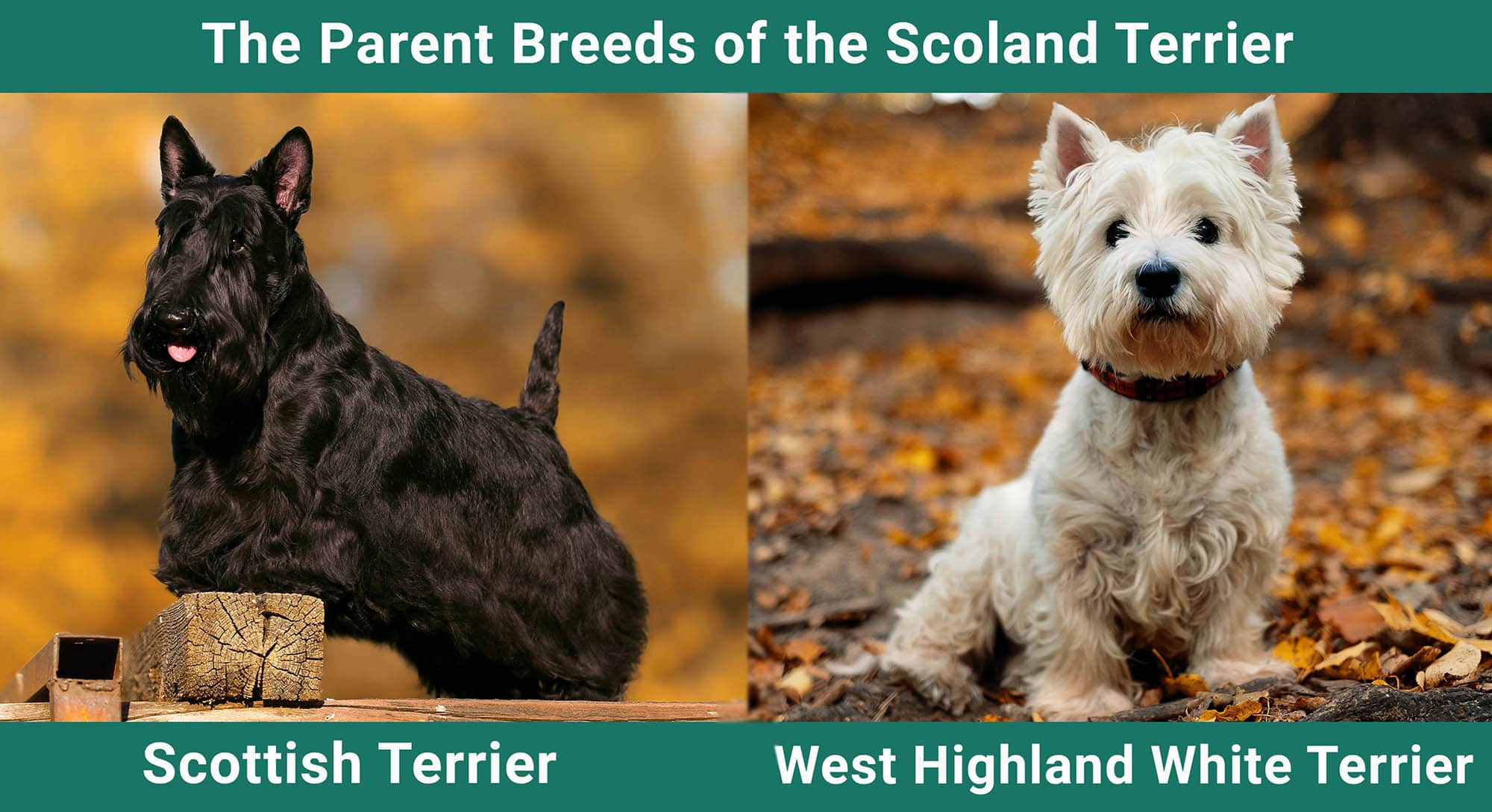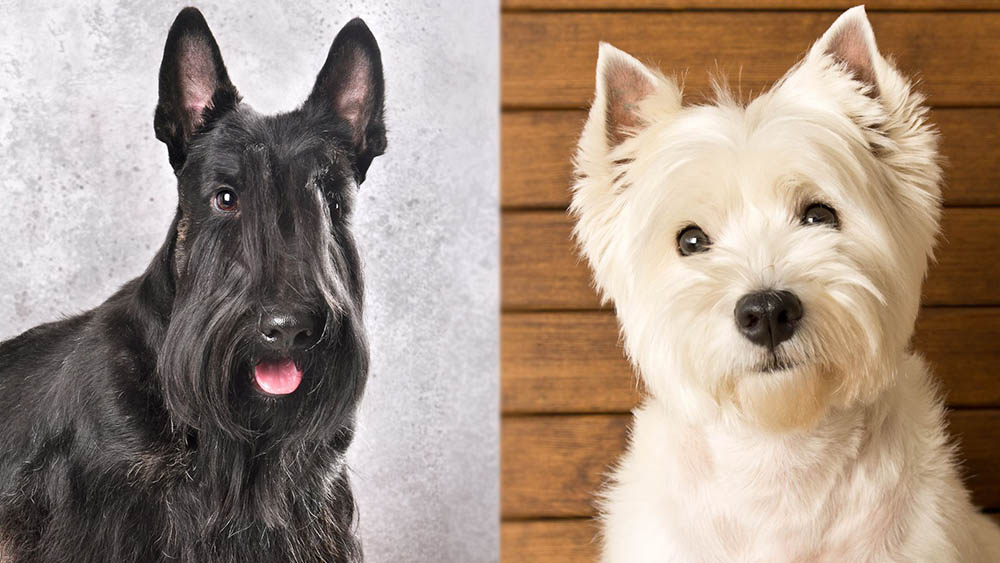Click Below to Skip Ahead
The Scoland Terrier is a cross between the Scottish Terrier (Scottie) and the West Highland White Terrier (Westie). As an offspring between two purebreds with delightful personalities, this hybrid offers a heartwarming combination of traits. It is energetic, playful, affectionate, and loyal. Most importantly, this dog makes an excellent addition to any household because of their charming looks and propensity for humor.
Are you looking to add a Scottie Westie mix to your household? Read on for in-depth details about the hybrid’s physical attributes, personality, care needs, and more.
Breed Overview
Height:
10–11 inches
Weight:
15–22 pounds
Lifespan:
12-15 years
Colors:
Black or fawn
Suitable for:
Active families, those looking that can keep up with a highly energetic dog
Temperament:
Energetic, playful, affectionate, friendly, intelligent, and loyal
As with all hybrids, it is nearly impossible to tell what a puppy will look like or their temperament. Scoland Terriers can inherit any combination of characteristics found in either purebred parent. Still, there are some common traits to expect.
For instance, most Scoland Terriers have the softer, rounder facial appearance of their Westie parents. They have a subtle fox-like look but with the body structures of their Scottie parents. These dogs are heavy-boned and have shorter legs and longer bodies. Fur-wise, they have double coats like both parents. The undercoat is soft and dense, and the outer coat is hard and wiry.
Temperament-wise, Scoland Terriers have a lot of love to give. They’re natural entertainers that are energetic, playful, and goofy. These dogs are also brilliant but stubborn.

Scoland Terrier Puppies
Don’t let the tiny bodies of Scoland Terrier puppies fool you; these are not your regular low to average-energy puppies.
As a hybrid of two brilliant working dogs with lots of drive, Scoland Terrier puppies are highly energetic. It would be best to channel their energy by offering enrichment games, walks, and plenty of activities to tire them out mentally and physically.
When left to their own devices, these puppies can get destructive. It is best to begin training as early as 8 weeks. Always keep sessions under 15 minutes and end them on a positive note. Because untrained Scoland Terriers can get unruly, you want to do yourself the favor of keeping your pups looking forward to learning new commands, tricks, and etiquette.

Temperament & Intelligence of the Scoland Terrier 🧠
Scoland Terriers are family-oriented dogs. They are affectionate, playful, fun, and highly opinionated. Also, they have a funny side they love to showcase, especially when they are the center of attention.
Another hard-to-miss attribute is that Scoland Terriers are always alert. They need early socialization to lower their risk of turning aggressive toward strangers and other pets.
Although small, these dogs have big brains that they enjoy putting to good use. They are relatively easy to train and often grasp concepts in just a few repetitions. However, they are also headstrong and prefer doing things on their own terms. If you want a well-mannered dog that obeys your commands, you must assume the position of an alpha.
Are These Dogs Good for Families?
Scoland Terriers are social creatures that love attention. They love the company of children and don’t mind spending hours with them, provided they are not mishandled. Although friendly, they can get grumpy and snap if roughed up by an excitable child.
Like most small dog breeds, Scoland Terriers are best paired with families with older children. These dogs are strong-willed and don’t always listen to commands, especially if they feel threatened.
According to some pet parents, the notion that Scoland Terriers and children don’t mix is merely a myth. These dogs are smart enough to learn respect and reciprocate it with kids and other pets. Generally, they can be around smaller kids, provided they are well-trained and socialized. However, it is important to supervise play with kids.
Does This Breed Get Along With Other Pets?
According to the American Kennel Club, around 14% of dogs experience separation anxiety1. Scottie Westie mixes love spending time around people, making them prone to feeling anxious if left alone for too long.
Fortunately, they also enjoy the company of other dogs, irrespective of their breed. With proper training and socialization, your pet doesn’t have to depend wholly on your company.
Merely because Scoland Terriers are good with other dogs doesn’t mean they get along with all other pets. These hybrids have a high prey drive and love chasing small things around. Generally, you cannot trust your dog with smaller pets like cats, bunnies, and hamsters.
Things to Know When Owning a Scoland Terrier
Scoland Terriers are highly adaptable and don’t mind if you don’t have a big, fenced yard. Although they love staying active, they adjust well to apartment living, provided you offer plenty of mental and physical stimulation.
Are you ready to adopt a Scottie Westie mix? Here are essential things you should know before adding the hybrid to your household.
Food & Diet Requirements
Scoland Terriers are small-sized dogs that will not cost you a fortune to feed. Still, they need high-quality food to pack them with the energy they need for their “work days”.
At least 1 cup of a well-balanced and highly nutritious kibble twice daily is enough to ensure your dog remains healthy, happy, and energized. Ensure your product is uniquely designed for small dogs and your pet’s specific life stage.
Because Scoland Terriers are prone to food allergies, the ideal product must also be free of grain-based proteins and artificial flavors.
https://www.instagram.com/p/CM-_3-iBfmM/?utm_source=ig_web_copy_link
Exercise
The Scottie Westie mixes are hybrids of two working farm dogs. The dogs have lots of energy and above-average mental and physical stimulation demands. Unlike most small dogs that require half an hour of low-intensity workouts, Scoland Terriers need 45 to 60 minutes of medium-intensity exercises daily.
Furthermore, these dogs have a big appetite for work. Apart from their daily exercise, you must keep them entertained throughout the day. Invest in toys that can keep your dog chewing, running, and rolling around to kill boredom. Pent-up energy can quickly leave your pet demolishing your pillows and digging up plants from your kitchen garden.
Long, moderate-paced walks can do the trick if you want to help your dog stay out of trouble. If you use public routes, leash training is necessary, and you must always control your pet’s movements. Again, Scoland Terriers have a strong prey drive and cannot resist the urge to chase squirrels, rats, and cats.
Training
Scoland Terriers are intelligent dogs. However, they can inherit the eager-to-please natures of their Westie parents or the super stubbornness of their Scottie parents. Most pups have a mix of both, which makes training relatively simple, provided you use the right strategies.
Ideally, training should start early before your doggo adopts a “know it all” attitude. Yummy treats, praise, and toys will do when you want to entice your pet to focus on training. Moreover, it is crucial to keep your sessions short and fun and provide firm, clear, and consistent instructions. Even if your pup is stubborn, they will submit to you if they perceive you as the pack leader.
Early socialization is also vital irrespective of your dog’s personality. Most Scoland Terriers are friendly and outgoing like their Westie parents. However, they are also suspicious of strangers and unknown pets like Scotties. Exposing your pet to as many new experiences, pets, and people as possible increases their chances of behaving desirably in different settings.
Grooming ✂️
Scoland Terriers are relatively low-maintenance dogs because they don’t shed a lot. They have soft and dense undercoats and weather-resistant hard and wiry outer coats. Use a pin brush to remove knots and tangles to keep the undercoat in tip-top condition. On the other hand, you should hand strip the outer coat to pluck loose hair while maintaining the fur’s texture.
Weekly coat maintenance will suffice to keep your furry companion looking their best. Expect the shedding to be a little heavier during shedding seasons when you have to brush your dog’s coat twice or thrice weekly.
Moreover, trim your pet’s coat every two to three months to prevent the fur from mopping dirt, debris, and mud. Three to four baths a year are enough because too many can trigger skin conditions that cause itching problems. Don’t forget to brush your dog’s teeth weekly and clip his nails monthly.
Health and Conditions
Scoland Terriers are relatively healthy dogs that enjoy 12 to 15 years of life. Their genetic influence as crossbreeds puts them at a lower risk of some health conditions prone to their parent breeds.
A reliable breeder will take prospective parent breeds through health checks before breeding them. This is crucial to securing healthy and happy puppies. Still, it is best to be vigilant of the following health problems, irrespective of where you purchase your Scoland Terrier.
- Skin & Tummy Allergies
- Joint Problems
- Von Willebrand Disease (VWD)
- Eye Conditions
Minor Conditions:
Skin & Tummy Allergies
Scottie Westie mixes are prone to food sensitivities typically caused by grain-based proteins. Also, they have sensitive skin prone to allergic reactions caused by environmental factors like dust or pollen. Other skin conditions to be highly alert for include Seborrhea and Atopic dermatitis.
It is best to rush to the vet if you notice signs like irritated skin, redness, or digestive problems. Most allergies are treatable through lifestyle or dietary adjustments.
Joint Problems
Up to 32% of all dogs suffer from some form of joint disorder. Joint problems, commonly associated with pain and lameness, are prevalent across all canine breeds; Scoland Terriers are no exception. They are prone to various concerns, including hip dysplasia, elbow dysplasia, and patella luxation.
Most joint problems are congenital abnormalities that can be dodged by breeding healthy dogs. If your furry friend is affected, you can reduce the stress on impacted joints through regular exercise, proper diets, and maintaining a healthy weight.
Moreover, it pays to schedule regular vet checks to better your odds of catching joint issues early before they cause extensive damage.
Serious Conditions:
Von Willebrand Disease (VWD)
Scoland Terriers can inherit von Willebrand disease from either parent. This bleeding disorder is caused by the deficiency of a protein (von Willebrand factor) that helps form clots. Signs of the disease include easy bruising and spontaneous bleeding from the mouth, nose, and reproductive parts.
Dogs with von Willebrand disease can live long and happy lives if the concern is well-managed. Without proper treatment, VWD can cause a myriad of other health issues or death.
Eye Conditions
Compared to other breeds, Scoland Terriers are more vulnerable to eye conditions, including dry eye syndrome and cataracts. Both concerns cause pain and cloudy vision and can lead to blindness if not addressed promptly. The ideal treatment depends on the severity of an eye condition and its underlying cause.
Male vs Female
Unless you want a Scoland Terrier for breeding purposes, it really doesn’t matter if you choose a male or female. Both have similar exercise, training, socialization, nutritional, and general care needs. Also, your male or female pet will thrive and become a pleasant family member if you spend adequate time and effort providing proper training and socialization.
Still, there are a few subtle differences between males and females that you should know.
Scoland Terrier males tend to be more aggressive and independent than females. They are happier being the sole pets and often have trouble tolerating rough play from kids and other pets. On the bright side, they make better watchdogs and can melt your heart with their undivided loyalty.
Female Scoland Terriers are more social and typically form close bonds with more than one person. They are also more tolerant of small kids and obey commands better than males. Although they also have a stubborn streak, they are generally easier to train and socialize.
3 Little-Known Facts About Scoland Terriers
1. Their Parent Breeds Were Expert Rat Exterminators!
Rodent infestations were a real menace in Scotland centuries ago. Dog breeds like the Scottie and Westie were intentionally created to help farmers protect their grain stores from vermin.
Scoland Terriers have the high prey drives of their parent breeds and are also expert rodent exterminators. Although training can make the dogs obedient, their prey drive will not allow them to leave your guinea pig or hamster in peace.
2. They Can Be Overly Yappy
Scoland Terriers can be super vocal, although it is possible to make them tone down a bit. Like their Westie parents, they are friendly and tend to vocalize as their way of communicating.
Also, these dogs are excellent watchdogs like their Scottie parents. They’ll bark loud and long at anything that seems off, which makes them reliable deterrents to intruders. If you find your dog too yappy for your liking, a kind correction can teach it to stop barking on command.
3. They Can Be a Little Pricey
A Scoland Terrier puppy from a reputable breeder cost between $1,400 and $2,000. The price can go as high as $3,500 depending on a breeder’s location and the quality and pedigrees of the parent breeds. Unfortunately, these hybrids are hard to find even from reputable breeders, meaning you have little or no chance of finding a cheaper Scoland Terrier up for adoption.
Final Thoughts
Scoland Terriers are fun-filled dogs with bright and infectious personalities. They are friendly, charming, and silly with their family members and don’t mind cuddling for short periods between “work” sessions. As energetic dogs, they thrive in busy households where they receive plenty of mental and physical stimulation.
Do you want a loyal and affectionate pet that also doubles as a competent watchdog? It is hard to go wrong with the Scoland Terrier.
Like both parent breeds, the hybrid has an astounding work ethic. Your pet will proudly do hourly perimeter checks and report to you if anything is amiss. In return for unwavering love and loyalty, you’ll need to give a blind eye to your dog’s strong-headed nature.
Featured Image Credit: (L) Natallia Yaumenenka, Shutterstock | (R) Bogdanovich_Alexander, Shutterstock












